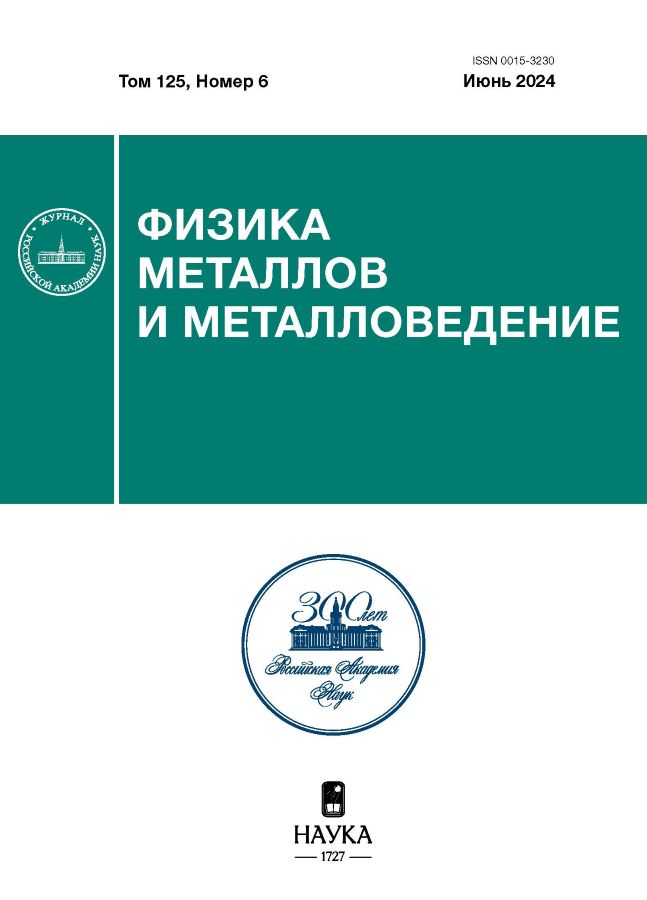Phase-structural state of τ-MnAl(Ga) alloys prepared at different cooling rates
- 作者: Fortuna A.S.1, Vazhinskii N.M.1, Nechaev K.S.1, Morozova T.A.1, Gorshenkov M.V.1, Karpenkov D.Y.1, Malyutina E.S.1
-
隶属关系:
- National University of Science and Technology MISiS
- 期: 卷 125, 编号 6 (2024)
- 页面: 721-731
- 栏目: СТРУКТУРА, ФАЗОВЫЕ ПРЕВРАЩЕНИЯ И ДИФФУЗИЯ
- URL: https://innoscience.ru/0015-3230/article/view/662927
- DOI: https://doi.org/10.31857/S0015323024060091
- EDN: https://elibrary.ru/WQKZHU
- ID: 662927
如何引用文章
详细
An alloy with a nominal composition of Mn55Al36Ga9 is prepared by four different methods which ensure different cooling rates. Two bulk samples are prepared by induction melting followed by water quenching from a homogenizing temperature of 1100oС; one of the samples was sealed in a quartz ampoule and subjected to water quenching, whereas the other sample directly was subjected to water quenching. Two samples are prepared in the form of ribbons by quenching from the melt on a rotating copper wheel at linear speeds of 10 and 40 m/s. Thus, samples quenched at different rates are prepared. For these samples, regularities of phase transitions occurred during heating are determined, and difference in the regularities for the bulk and rapidly quenched samples are found. Based on the data obtained, we make an assumption that the γ2 → τ phase transition has features of a bulk transition. Magnetic hysteretic properties of the rapidly quenched ribbons are measured. The high thermal stability of the rapidly quenched ribbons alloyed with gallium is shown.
全文:
作者简介
A. Fortuna
National University of Science and Technology MISiS
编辑信件的主要联系方式.
Email: fortuna.as@misis.ru
俄罗斯联邦, Moscow, 119049
N. Vazhinskii
National University of Science and Technology MISiS
Email: fortuna.as@misis.ru
俄罗斯联邦, Moscow, 119049
K. Nechaev
National University of Science and Technology MISiS
Email: fortuna.as@misis.ru
俄罗斯联邦, Moscow, 119049
T. Morozova
National University of Science and Technology MISiS
Email: fortuna.as@misis.ru
俄罗斯联邦, Moscow, 119049
M. Gorshenkov
National University of Science and Technology MISiS
Email: fortuna.as@misis.ru
俄罗斯联邦, Moscow, 119049
D. Karpenkov
National University of Science and Technology MISiS
Email: fortuna.as@misis.ru
俄罗斯联邦, Moscow, 119049
E. Malyutina
National University of Science and Technology MISiS
Email: fortuna.as@misis.ru
俄罗斯联邦, Moscow, 119049
参考
- Coey J.M.D. Permanent magnets: Plugging the gap // Scripta Mater. 2012. V. 67. P. 524–529.
- Kontos S., Ibrayeva A., Leijon J., Mörée G., Frost A.E., Schönström L., Gunnarsson K., Svedlindh P., Leijon M., Eriksson S. An Overview of MnAl Permanent Magnets with a Study on Their Potential in Electrical Machines // Energies. 2020. V. 13. P. 5549 (1–14).
- Smith Stegen K. Heavy Rare Earths, Permanent Magnets, and Renewable Energies: An Imminent Crisis // Energy Policy. 2015. V. 79. P. 1–8.
- Passenger for Sustainable and Efficient RE-Free Magnets [электронный ресурс]: Developing Sustainable Rare-Earth-Free Permanent Magnets, URL: https://passenger-project.eu/ (дата обращения 12.12.2023).
- Zhao S., Wu Y., Zhang C., Wang J., Fu Z., Zhang R., Jiang C. Stabilization of t-phase in carbon-doped MnAl magnetic alloys // J. Alloys Compounds. 2018. V. 755. P. 257–264.
- Mix T., Bittner F., Müller K.-H. Schultz L., Woodcock T.G. Alloying with a few atomic percent of Ga makes MnAl thermodynamically stable // Acta Mater. 2017. V. 128. P. 160–165.
- Mix T., Woodcock T.G. Advanced thermal stability investigations of the Mn–Al-Ga system // Results in Mater. 2020. V. 5. P. 100068 (1–4).
- Zhao. S., Wu. Y., Jiao Z., Xu Y., Wang J., Zhang T., Jiang C. Evolution of Intrinsic Magnetic Properties in L10 Mn-Al Alloys Doped with Substitutional Atoms and Correlated Mechanism: Experimental and Theoretical Studies // Phys. Rev. Applied. 2019. V. 11. P. 064008 (1–13).
- Zhao H., Yang W.Y., Shao Z.Y., Tian G., Zhou D., Chen X.P., Xia Y.H., Xie L., Liu S.Q., Du H.L., Han J.Z., Wang C.S., Yang Y.C., Yang J.B. Structural evolution and magnetic properties of L10-type Mn54.5Al45.5-xGax (x = 0.0, 15.0, 25.0, 35.0, 45.5) phase // J. Alloys Compounds. 2016. V. 680. P. 15–19.
- Shelekhov E.V., Sviridova T.A. Programs for X-ray analysis of polycrystals // Metal Sci. Heat Treatment. 2000. V. 42. № 7–8. P. 309–313
- Fang H., Kontos S., Ångstrom J., Cedervall J., Svedlindh P., Gunnarsson K., Sahlberg M. Directly obtained τ-phase MnAl, a high performance magnetic material for permanent magnets // J. Solid State Chem. 2016. V. 237. P. 300–306.
- Jia Y., Wu Y., Xu Y., Zheng R., Zhao S., Skokov K.P., Maccari F., Aubert A., Gutfleisch O., Wang J., Wang H., Zou J., Jiang C. Roadmap towards optimal magnetic properties in L10-MnAl permanent magnets // Acta Materialia. 2023. V. 245. P. 118654 (1–16).
- Mix T., Müller K.-H., Schultz L., Woodcock T.G. Formation and magnetic properties of the L10 phase in bulk, powder and hot compacted Mn-Ga alloys // J. Magn. Magn. Mater. 2015. V. 391. P. 89–95.
- Bittner F., Schultz L., Woodcock T.G. Twin-like defects in L10 ordered τ-MnAl-C studied by EBSD // Acta Mater. 2015. V. 101. P. 48–54.
- Fortuna A.S., Morozova T.A., Karpenkov D.Yu., Gorshenkov M.V. Features of Phase Composition and Structure of Rapidly Quenched Ferromagnetic Mn–Al–Ga Alloy // Phys. Met. Metal. 2024. V. 125. № 2. P. 196–202.
- Xiang Z., Deng B., Zhang X., Wang X., Cui E., Yu L., Song Y., Lu W. Nanocrystalline MnAlV rare-earth-free Permanent Magnetic Alloys with Improved Magnetization and Thermal Stability // Intermetallics. 2020. V. 116. P. 106638 (1–6).
补充文件


















